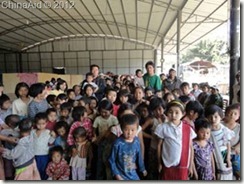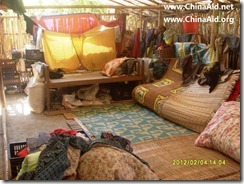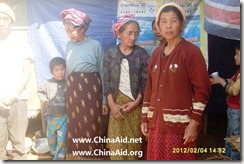Voice of China (VOCN), Yunnan bureau

Attempts to negotiate a ceasefire between the Burmese government and the Kachin Independence Army (KIA) in the Kachin minority areas in the border region with China have time and again been interrupted by the outbreak of fighting. Since June 2011, the two sides have been trading fire without pause and the small skirmishes have escalated, resulting in the displacement of what the United Nations estimates to be some 60,000 refugees who have been forced to leave their homes and head north. Already, more than 25,000 of them have poured into China’s Dehong prefecture in the province of Yunnan.
According to aid workers from the local churches, the intensity of the armed clashes appears to have eased for now, but all the refugee camps lack drinking water and some refugees have come down with diarrhea, malaria and upper respiratory tract infection. The Chinese government not only is refusing to provide humanitarian aid, but is also trying to prevent refugees from crossing the border into China.
Influx of refugees is still rising sharply
According to informed sources, since the armed clashes broke out in June 2011, 41 refugee camps have been set up in Yunnan province for more than 60,000 people, with some 25,000 16 camps in Yingjiang [county] which borders Burma. Many refugees have to leave their homes to live in these temporary camps, while others have taken temporary refuge in churches, schools and villages. There are still about 3,200 families totaling more than 9,000 people waiting for accommodations, and 13,000 sets of bedding are still needed.
According to Partners Relief & Development (Partners) in Burma, more than 60,000 people have been displaced along China-Burma border. An aid worker for Partners surnamed Erickson said, “The number of people trying to escape the clashes with Burmese government troops is certainly in the tens of thousands. The Burmese government troops forcibly took people’s land and belongings, and even arrested them at times. Therefore, people are fleeing in a hail of bullets. In my view, most of these people are fleeing out of fear.”
According to Chinese non-governmental relief workers who are offering aid to refugees in Yingjiang county, 1359 people are in a camp near Laying, 400 of whom are children. Papaya Dam has a camp with 830 refugees, of whom 400 are children. “Sanitation conditions are bad, potable water is scarce, electricity is unreliable. Food and clothing and medical services and medicines are all in short supply. They remain a top priority and they are urgently needed right now.” According to reports, eight camps on Nong Island in Ruili had at one point run out of food for three days, and are still suffering shortages even now. One of the camps, at Datougou, has 280 refugees, half of whom are children. Each family needs about a quart of cooking oil every two weeks. Food and cold and cough medicines are in short supply, and they need more than 10 cooking pots as well.
A relief worker in Yunnan’s Yingjiang county, Dehong prefecture, said, “The current statistics on refugees reportedly are from the United Nations. Just in the border area of Dehong prefecture alone, there are more than 57,000. At many camps, four or five families are crowded into one shelter—there are still not enough shelters for the refugees. Many camps lack bedding and medicines, and worst of all, a lot of children have no school to go to. And that’s in places where things are actually pretty good. They really are eager for us to go there and help them out.”
A Voice of China correspondent from the Yunnan bureau who has recently spent a lot of time at the refugee camps said he found that many refugees were surviving with great difficulty. Local Christian volunteers are doing their utmost to help them, but they are suffering from a serious shortage of hands and there’s much to be done. He appealed for help from Christians everywhere, saying, “The best would be to have volunteer organizations, especially those that can organize classes for them and give them some instruction in many areas related to health and mental and spiritual matters.”
According to a Kachin representative in charge of refugee issues, the armed clashes are sporadic, and there is no ceasefire in sight because neither party has any desire to negotiate an agreement. The so-called end to the fighting and talk of a ceasefire is nothing more than just talk, and that means “the refugees cannot return home yet.” As for “rebuilding their homes, this is just an airy dream with no substance.”

For several decades, Burmese government troops have been “reorganizing” the independent armed forces in the ethnic minority areas, “suppressing the bandits and quelling rebellions,” which resulted in continuous conflicts and repeated battles that had already forced hundreds of thousands of civilians in the Sino-Burmese border areas to flee their homes. During this time, human rights groups have many times accused the Burmese forces of repeated violations of basic human rights, all kinds of abuse and atrocities against humanity, and war crimes, including rape, forced labor and torture. Among those raped were three women are from China. Other victims include businessmen and banana farmers. According to a source from China who requested anonymity, some Chinese citizens and family members are still unaccounted for. Furthermore, all contact has been lost with them and they are feared dead or missing.
Has there been a cover-up or a deliberate attempt to confuse? The facts will reveal who is right and who is wrong!
According to an analyst with the Association of Christian Journalists, both the United States and the European Union are in favor of the Burmese government resolving its conflicts with the armed forces of the minority groups. Not long ago, negotiations were going well between the Burmese government and other minority “rebel groups” along the Sino-Burmese and Thai-Burmese border. However, the refugee crisis not only cast a shadow over Sino-Burmese border security, creating hidden dangers, it also shattered the attempts and hopes of the new Burmese government to end Burma’s international isolation and the sanctions against it. Even Burma’s chief negotiatior, Aung Thaung, has said that it would take at least three years to bring peace to Kachin state.
However, Global Times reporter Cheng Gang, thinks otherwise. According to him, the reports of waves of Burmese refugees entering China do not square with the facts along the Sino-Burmese border. According to his reports, he traveled to the Sino-Burma border on February 9 and from first-hand reporting learned that from a geographic standpoint, there is no natural border between China and Burma, mountains and rivers and even farmland are connected. Furthermore, people on the two sides of the border are of the same ethnic group, so the border people frequently and easily cross the border, to the extent that many Burmese children even cross the border to go to school in China. Whenever the situation in Burma becomes unstable, there will be more than the usual number of people coming to China to live with their relatives and friends and take shelter from the storm. As everyone knows, the refugees from Kachin state were able to navigate the many obstacles and cross the border with such ease because they were already familiar with Yunnan’s border situation. Cheng Gang’s report is a case of “protesting too much.” After all, don’t facts speak louder than words? In fact, China’s 3G website has posted photos taken by netizens of the area around border markers #6 and 8, showing nearly a thousand Burmese refugees, most of whom are from the Jingpo and Lisu minority groups who live on both sides of the border.
Nevertheless, the media and international organizations have only very limited contact with those in the Kachin state. Since the Chinese government has not public acknowledged the fact of the refugee crisis, it is hard to know what is going on unless one actually goes there. This is similar to what happened in 2009, when Burmese government troops clashed with Kokang ethnic armed forces of group in Shan state, disturbing local business and causing tens of thousands of refugees to flee into China. In January this year and November last year, the Chinese government created a neutral zone along the border for peace talks in Ruili between the Burmese government and the “rebel minority groups.” So how can the Global Times act like it is blind and deaf?
A Taiwanese researcher from National Chengchi University, said “The refugee issue in the border area is not only a headache for the local provincial leaders but is also a hassle for the authorities in Beijing. Therefore, they cannot stay out of it. Otherwise, they could get caught flat-footed at any time by some problem. The areas in Kachin state where the conflicts are occurring are close to a disputed hydro-power dam built with Chinese aid. The ongoing armed clashes not only threaten the peace, but also threaten the safety of one billion dollars in Chinese trade and investment.” A Burmese issues analyst in Ruili also said that China hosted the negotiation to protect its own economic interest. “China has invested in a lot of projects in northern Kachin state, and in particular in the region controlled by the KIA. So they need for there to be peace in that region,” the analyst said.
Unable to operate normally, Laiza Border Crossing is almost an empty shell
According to Naw Din, editor-in-chief of the Kachin News Group, the ongoing armed clashes in Kachin state have not only made it impossible for the border crossings to operate normally, but has also caused the refugee crisis, seriously jeopardizing Sino-Burma border security. Residents in the Kachin capital of Myitkyina told reporters thatthe number of conflicts between Burmese government troops and KIA has dropped since January and they are on a smaller scale than before, but they are still seriously affecting the lives of Burmese civilians in the areas of armed conflict, especially along the border.
According to the Voice of Democratic Burma, ceasefire talks mediated by third parties have all failed, and the Burmese military has refused to follow President Thein Sein’s ceasefire order. The military operations against the KIA did not even stop during 2012 New Year celebrations, and the exchange of fire even escalated at times. It is reported that Burmese soldiers recently arrived at Bhamo, in Kachin state, by boat and the armed clashes between Burmese soldiers and the KIA in Bhamo have intensified. According to analysts, Burmese troops could soon launch even larger scale operations against the KIA. Witnesses said that there’s been “an obvious increase” in Burmese soldiers in Bhamo recently. Currently, Burmese government troops have deployed about 600 soldiers 20 miles from the KIA headquarters in Laiza.
Burma’s Kachin minority and Lisu minority are actually the same ethnicity as China’s Jingpo and Lisu minority groups in—only their names are different—and they are considered cross-border ethnic groups. There are 120,000 Jingpo minorities in China, and according to statistics from the 1970s, Burma’s Kachin 560,000 miorities live in the mountains of Kachin state, the Ruili river basin, the mountains of Shan state, and Kengtung region. A small number of Kachin also live in the mountain area of western Banga, Assam, India. According to historical records and folklore, the Kachin are from the Tibetan Plateau and are descendents of the Diqiang people who moved south. In Chinese history, they were known as “Xunchuanman” and “Echangman.” Through movies and television shows, people know quite a lot about with the Myitkyina Victory of the Chinese Expeditionary Force. How can the Chinese people continue the pacific practice of bowing to adversity and keeping silent?
Many bloggers have pointed out that the refugee crisis along the Sino-Burmese border not only brings a certain amount of risk to local stability, it also poses the greatest threat yet to Burma’s new civil government in. Some bloggers said, “China should act to prevent the replay of Kokang lessons.” And some even said, “China should prepare for a war with Burma.” “Independence for northern Burma!” “That land was originally China’s. Even if China can’t get it back, China should at least stop Burma from controlling it.” “Whether out of humanitarianism or to protect our economic interests, peace and stability along the border, our country must and is able to offer
Good Samaritans, Behold! Our Lord Jesus Christ taught us, “Feed them!”
Who are the neighbors of those children in the Kachin refugee camps?
(Brothers and sisters are urged to read Luke 9 & 10.)
China Aid Contacts
Rachel Ritchie, English Media Director
Cell: (432) 553-1080 | Office: 1+ (888) 889-7757 | Other: (432) 689-6985
Email: [email protected]
Website: www.chinaaid.org



